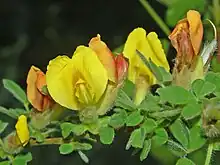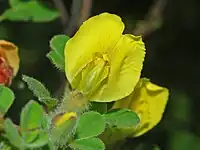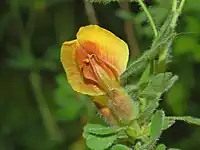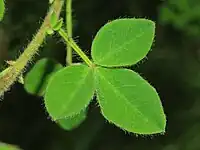Cytisus hirsutus
Cytisus hirsutus (clustered broom or hairy broom) is a perennial plant belonging to the genus Cytisus of the family Fabaceae.
| Cytisus hirsutus | |
|---|---|
 | |
| Scientific classification | |
| Kingdom: | Plantae |
| Clade: | Tracheophytes |
| Clade: | Angiosperms |
| Clade: | Eudicots |
| Clade: | Rosids |
| Order: | Fabales |
| Family: | Fabaceae |
| Subfamily: | Faboideae |
| Genus: | Cytisus |
| Species: | C. hirsutus |
| Binomial name | |
| Cytisus hirsutus L. | |
| Synonyms[1] | |
|
List
| |
Description
Cytisus hirsutus reaches on average 30–40 centimetres (12–16 in) of height, with a maximum height of about 100 centimetres (39 in). The stem is more or less ascendent, woody in the lower part, branched, with ascending annual and herbaceous branches (suffruticose) with hairs 3 millimeters long (hence the Latin name hirsutus of this species, meaning hairy). The small deciduous leaves are trifoliate, ovate to elliptic, hairy on both sides, 18–25 millimetres (0.71–0.98 in) long, with a petiole. The flowers are initially orange-yellow, then tend to be colored with reddish brown. The flowering period extends from April through June. Its legumes (seed pods) are 25–40 millimetres (0.98–1.57 in) long, very hairy and mature in late Summer.
Gallery
 Flower |
 Flower |
 Leaves |
Distribution
This plant occurs in Turkey, Austria, Czechoslovakia, Hungary, Switzerland, Albania, Bulgaria, former Yugoslavia, Greece, Italy, Romania and France.
Habitat
These plants can be found on calcareous and arid environments, such as dry meadows and slopes at the edge of the woods. They are typically found at an altitude of 0–1,500 metres (0–4,921 ft).
References
- "The Plant List: A Working List of All Plant Species". Retrieved April 3, 2014.
- Pignatti S. - Flora d'Italia - Edagricole – 1982. vol. III
- Tutin, T. G. et al., eds. 1964–1980. Flora europaea
- "Cytisus hirsutus". Germplasm Resources Information Network. Agricultural Research Service, United States Department of Agriculture.